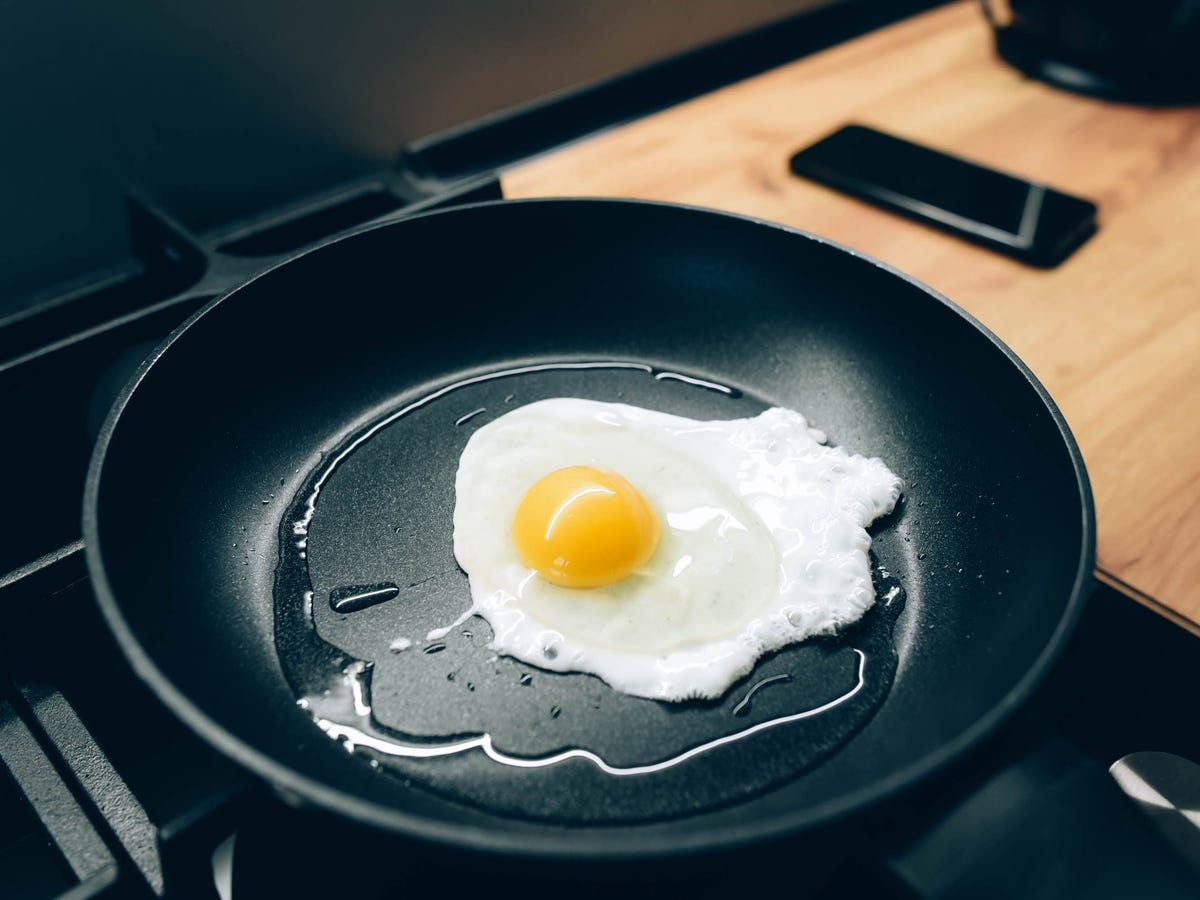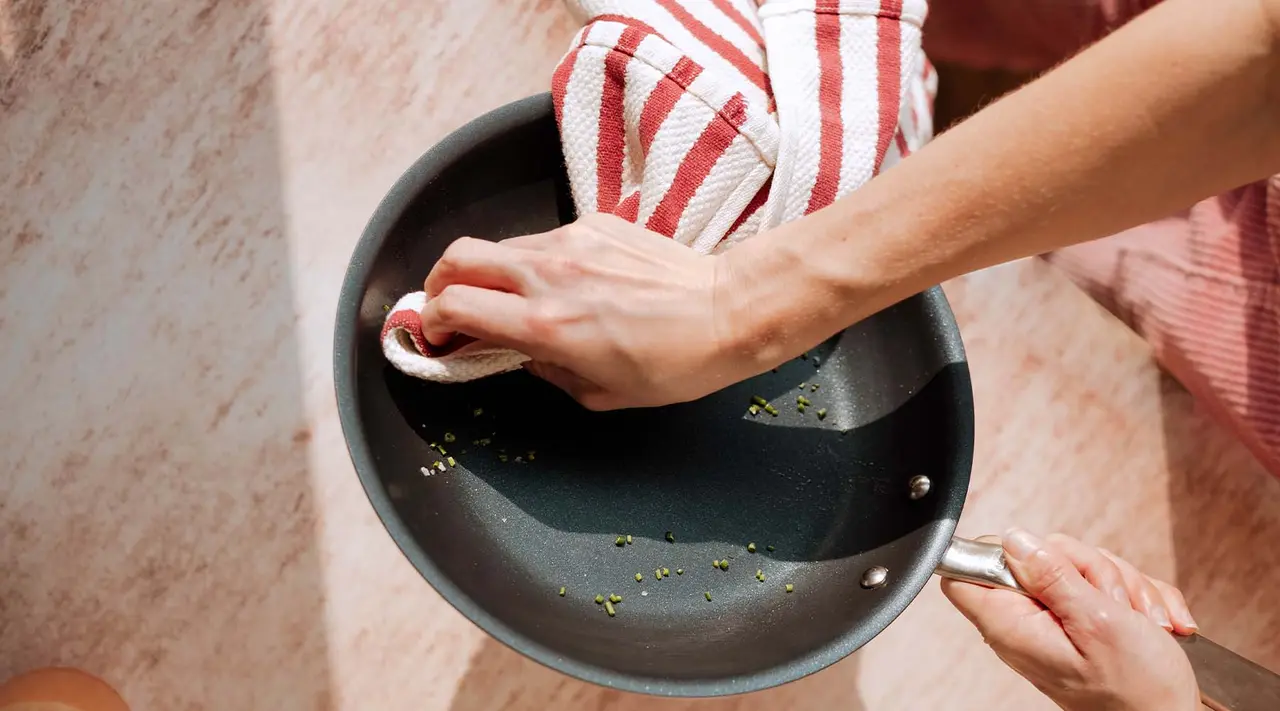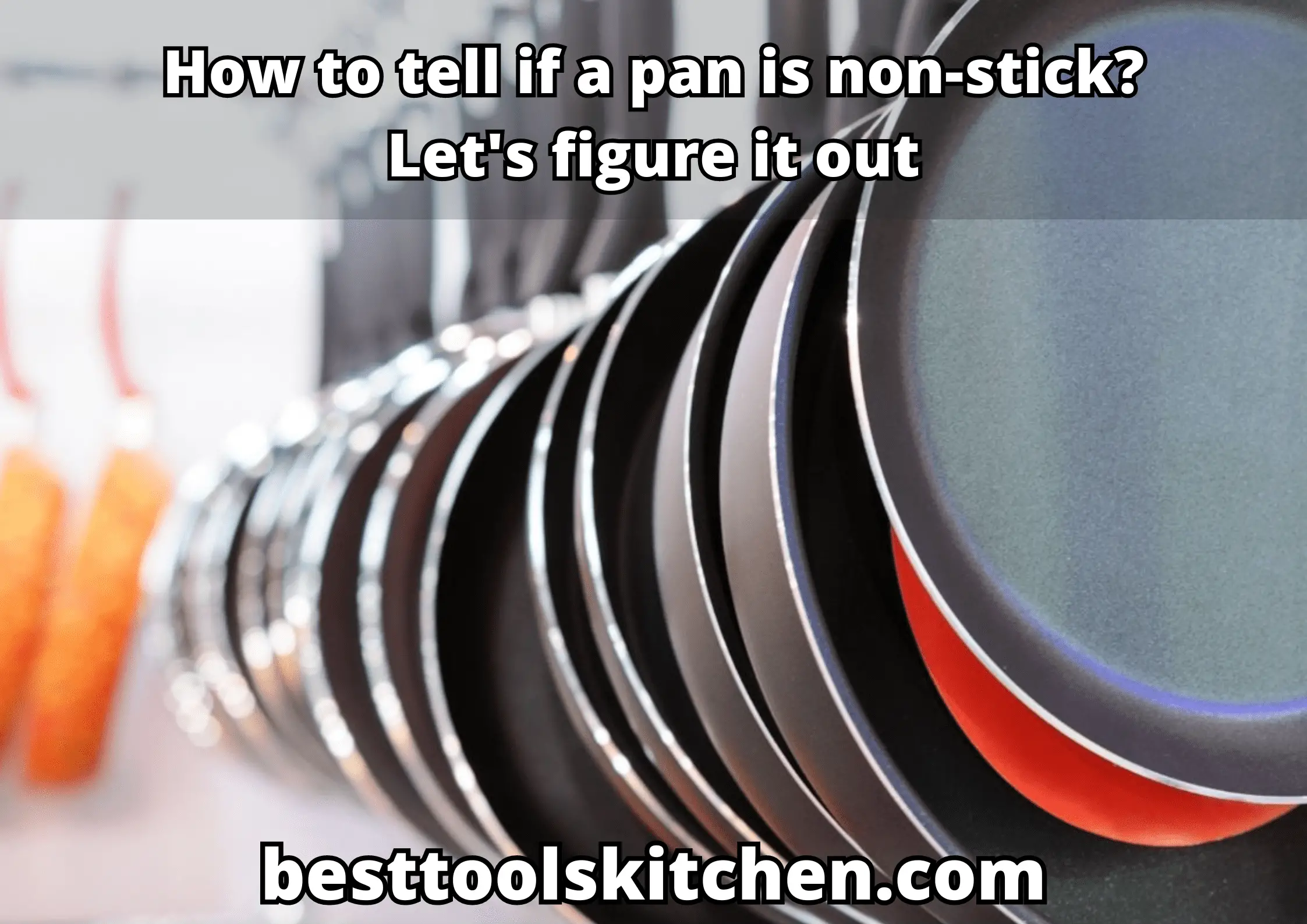This cookware is popular in kitchens worldwide due to its convenience and ability to cook delicate foods like eggs, fish, and pancakes without health risks.
It’s important to determine if a pan is non-stick for a number of reasons. First of all, it assists users in comprehending the proper cooking methods and utensils for usage with non-stick cookware.
Second, knowing if you have a non-stick pan aids in avoiding any health hazards that food-sticking pans may present.
Finally, by selecting the appropriate cookware for particular recipes and cooking methods you can save time and work in the kitchen by understanding what makes non-stick pans safe and useful.
How to tell if a pan is non stick: visual inspection

If you’re not sure if you have a non-stick pan, you can start with a simple visual inspection. One can determine whether or not they have non-stick pans by looking for particular indicators on their surfaces.
Smoothness and shine
Non-stick pans’ surfaces usually have a glossy, smooth appearance. Touch the cooking surface with your fingertips to experience how non-stick pans feel smooth and nearly slippery.
The unique coating that keeps food from sticking to non-stick cookware is what gives non-stick pans their smoothness. One good sign that you have nonstick pans is if the surface is neither uneven nor harsh.
Presence of a coating
Examine the pan’s exterior for evidence of a specialty coating. The nonstick coating on non-stick pans is composed of ceramic, Teflon coating, or cast iron metal surface. Unlike the coating on normal pans, which causes food to stick to it, the nonstick coating is evenly sprayed across the cooking area to create a barrier that prevents food from sticking to the pan and uses less oil.
When purchasing non-stick pans, look for a uniform, evenly applied dark gray coating that completely covers the nonstick surface, leaving no apparent patches or exposed metal regions.
Brand markings or labels indicating nonstick pans
It is common for manufacturers to clearly mark their non-stick pans. Look for non-stick pans’ labels or brand marks that specifically identify items as non-stick pans or list the ingredients that go into making the coating. These non-stick pans’ indicators reassure the user about the pan’s intended functionality by clearly indicating that it is a non-stick pan.
Visual assessment, which relies mostly on the non-stick pan surface features and unique markings or labels, is an easy first step in identifying non-stick pans. Nonetheless, more examinations and observations can confirm the nonstick pans’ qualities for certainty.
How to tell if a pan is non-stick: physical characteristics

A vital way to determine the qualities of nonstick pans is to physically inspect and feel the nonstick pans. It is possible to learn more about non-stick pans by evaluating the tactile characteristics of the surface.
Smoothness vs. roughness
Run your fingers over a nonstick pan cooking surface. Most non-stick pans usually have an extremely smooth feel, similar to a polished surface. This smoothness indicates that it has a non-stick pan coating on it that keeps food from sticking to it.
On the other hand, because of the bare metal surface, non-stick pans without a coating may feel coarser or have more textural imperfections.
Texture and slickness
When touched, non-stick pans frequently seem slick or slippery. This feeling suggests that there is a layer on the nonstick pan that prevents food from sticking to it.
Because of its unique non-stick coating, a non-stick pan usually feels smoother to the touch and provides less resistance than standard pans that lack non-stick surfaces.
Resistance to scratches or abrasions
Examine non-stick pans’ surfaces gently for signs of abrasion or scratches. In order to prevent surface damage, non-stick coatings are typically made to tolerate the use of non-metal utensils. If the surface remains smooth and doesn’t change, this is most likely a non-stick pan with cast iron or Teflon coating.
A sturdy non-stick pan will be resilient to small scratches, maintaining the integrity of its coating and extending its nonstick life.
Assessing the non-stick pans’ surfaces by tactile and tactile evaluation yields important information about whether or not they are non-stick. To prevent inadvertent damage that could harm the nonstick pans, it’s crucial to handle the nonstick pan carefully during the assessment process.
Water test

The water droplet test is a simple and trustworthy way to determine nonstick pans. This test provides important information on nonstick pans by evaluating the behavior of water when it is applied to the surface.
Explanation of the water droplet test
Because non-stick coatings repel water and stop it from sticking to the surface, the water droplet test works.
The water droplets won’t spread or stick to the pan if it has a dependable non-stick coating, demonstrating the pan’s capacity to deflect liquids and stop food from sticking to its surface.
Steps to perform the test
This is a simple test that looks at the behavior of water on the pan’s surface to provide important clues about its non-stick qualities.
Preparing the pan
Make sure the pan is dry and clean before doing the water droplet test. Moisture, food particles, or leftover oil could tamper with the test results. Accurate evaluation is the pan is non-stick is ensured by washing it with a mild dish soap and water and then letting it air dry.
The pan is prepared for the water droplet test to ascertain its non-stick qualities after it has been cleaned and dried.
Applying water droplets
To perform this portion of the test, adhere to these steps:
- Use a small amount of water: carefully apply multiple droplets to various parts of the pan’s surface using a teaspoon or small amount of water. Evenly scatter the droplets over the different areas of the cooking surface.
- Allow the droplets to settle: after applying the water droplets, give them time to settle. Don’t move them about. For a brief period, let the droplets remain on the pan’s surface without stirring or shifting it.
One of the best ways to evaluate a pan’s non-stick coating — its capacity to repel water — is to spread water droplets uniformly across its surface and watch how they react.
Observing water behavior
To closely watch and assess their behavior, take the following actions:
- Take note of the formation of beads: in a pan with good nonstick qualities, the water droplets usually form distinct beads that sit on the surface without spreading out. Water tends to be repelled by non-stick coatings, which causes droplets to form and hold their shape instead of dispersing or being absorbed by the surface.
- Minimal spreading or adhesion: the water droplets should not stick to the pan’s surface or spread out too much. When the pan is tilted, they should slide across without adhering or leaving residue behind, proving the non-stick nature of the coating.
- Evaluate in several areas: watch how the water droplets behave on various parts of the pan’s surface. The droplets’ uniform behavior throughout the surface attests to the pan’s general non-stick properties.
The presence and thickness of a non-stick coating on the pan’s surface can be reliably verified by carefully monitoring and assessing the actions of the water droplets.
Heat test
Understanding a non-stick pan’s heat resistance is vital to ensure its safe and effective use in the kitchen.
Importance of heat resistance in non-stick pans
For many non-stick pans, heat resistance is an essential feature. Non-stick pans, which are usually composed of ceramic materials, have temperature restrictions and distribute heat evenly.
Overdoing it may lead to coating degradation, which could release toxic fumes and jeopardize the nonstick properties of the pan. Understanding a pan’s heat resistance guarantees both its longevity and safe use.
Conducting a heat test
Users can evaluate a pan’s resistance to temperature changes without sacrificing its nonstick qualities by doing a heat test.
Preparing the pan
Be sure the pan is dry and clean before starting the heat test. Moisture or leftover food particles could skew the results of the test. To prevent thermal shock, make sure the pan is also cool or at room temperature, especially if it was previously used or cleaned in hot water.
The pan is prepared for the heat test to assess its heat resistance and possible effect on its non-stick properties once it has been cleaned and brought to a suitable temperature.
Heating the pan
After cleaning and drying, place the pan on a low- to medium-heat stovetop burner. In order to raise the pan’s temperature gradually, it is imperative that you begin with a low heat setting.
Give the pan a few minutes to warm up gradually. As it warms up, keep a watchful eye out for any changes on its surface. Refrain from heating the pan above the suggested temperature range.
When the pan is heating, proceed with caution and do not leave it alone. Keep an eye on the pan’s surface at all times for any changes or indications of damage.
Observing any changes in the surface or coating
Inspect the pan for indications of surface or coating alterations. Overheating is frequently indicated by discoloration, flaking, blistering, or the release of strange odors.
Keep an eye out for any changes to the nonstick cookware. The pan’s heat resistance may have been exceeded if the surface starts to exhibit signs of damage, starts to lose its slickness, or both.
Determining the pan’s heat resistance and ability to retain its non-stick qualities at different temperatures requires doing a heat test, which involves progressively heating the pan and monitoring any changes to its surface or coating.
How to tell if a pan is non-stick: cooking performance
It is crucial to assess a non-stick pan’s cooking performance using real food experiments to see how well it keeps food from sticking and how simple it is to clean up after usage.
Cooking an egg or pancake without oil:
- Turn it down to medium heat and preheat the sanitized non-stick pan.
- Pour a pancake batter or crack an egg onto the pan and coat it with it, using as no or less oil as necessary compared to other pans that food sticks to.
- As the dish cooks, follow the suggested cooking time, checking on it occasionally.
Assessing food release and sticking:
- Keep an eye on the food’s behavior as it cooks. Food should move around easily in a non-stick pan without adhering to the surface.
- Gently move or flip the food using a spatula. When a non-stick pan is working properly, food releases from it with ease and leaves no residue or takes too much effort to move.
Cleaning ease after cooking:
- Once cooked, evaluate how simple it is to clean the pan. A non-stick pan ought to be simple to clean and require little work.
- To clean the pan, use a gentle sponge or cloth dipped in mild dish soap. After using, take note of if there is any food sticking to the surface or whether the non-stick coating seems damaged or changed.
These food tests give important information on how well the pan doesn’t stick. An effective non-stick pan will release food easily, adhere to objects less, and clean up easily, making cooking hassle-free.
Maintenance and care

A pan’s characteristics must be preserved through adequate maintenance in order to guarantee its longevity and peak performance.
Proper cleaning methods:
- After every usage, hand wash the non-stick pan using a gentle dish soap and a soft sponge or towel. Steer clear of scouring pads and harsh cleaners as they may cause scratches or erode the non-stick coating.
- Applying minimal force, gently clean the smooth surface to get rid of any food residue. To avoid damage or watermarks, give the pan a good rinse with water and let it air dry fully before storing.
Using wooden or silicone utensils that do not damage the non-stick surface:
- Use plastic, nylon, wooden, or silicone utensils to avoid scratching or damaging the non-stick coating. Metal utensils can compromise the smooth surface, leading to a reduction in their non-stick properties.
- It is important to exercise caution when cooking and refrain from using utensils with sharp edges or metal ones as they may cause scratches or chips in the non-stick coating of the pan.
Storing the pan correctly:
- Non-stick cookware should be kept cold and dry. To avoid scratching or denting the coating, don’t stack other pans on top of them or place heavy things on top of them.
- To avoid direct contact and potential damage to the non-stick surface, place soft cloth layers or protective pan separators between stacked pans.
By following these maintenance recommendations, you may prolong the life and efficiency of your nonstick cookware. Using the right cleaning techniques, picking out utensils with care, and storing the pan properly all help to keep its non-stick qualities intact over time.
Conclusion

Adhering to proper maintenance practices, including gentle cleaning methods, utensil selection, and appropriate storage, is paramount to preserving the needed properties over time.
The process involves a multi-faceted approach, encompassing visual inspection, physical assessments, simple tests, cooking trials, and conscientious maintenance. The quest to identify a safe pan relies on a combination of these methods to ensure accuracy and reliability.
To put it simply, determining if you have a non-stick pan demands an all-encompassing strategy that incorporates usage, maintenance, testing, and observation. When these techniques are combined, users may be sure of a pan’s non-stick qualities, which guarantees effective and long-lasting nonstick cookware performance.
FAQ
How do you prove a pan is non-stick?
Try the water droplet test: if drops of water land on the pan’s surface and readily slide up, it’s probably a non-stick pan.
What is considered a non-stick pan?
A pan with specialized nonstick coatings, like ceramic or cast iron pans, that prevents food from sticking during cooking.
What are the symptoms of a non-stick pan?
The characteristics of nonstick cookware include glossy, smooth surfaces, nonstick coatings, simple food release without sticking, and little residue left over after cooking and washing.
